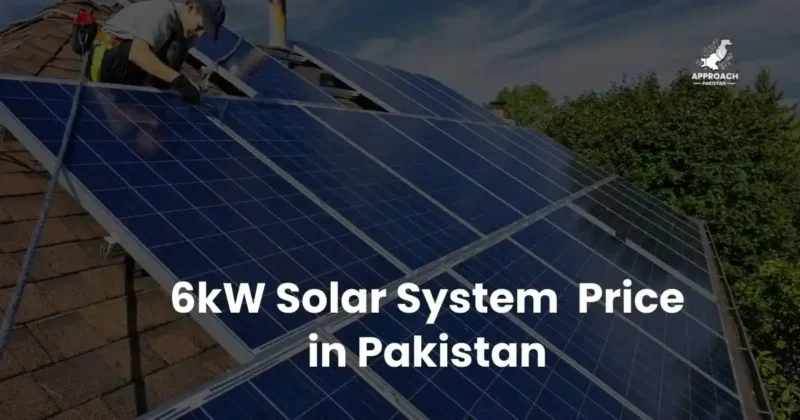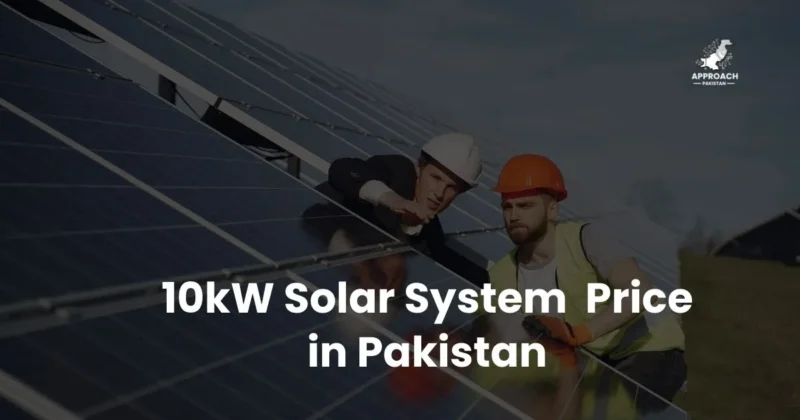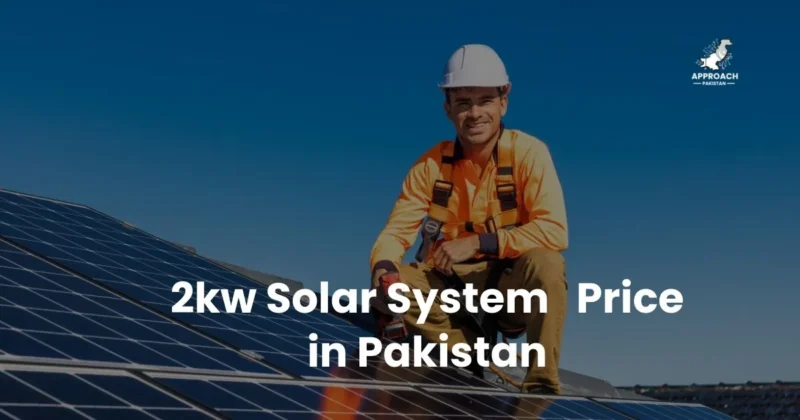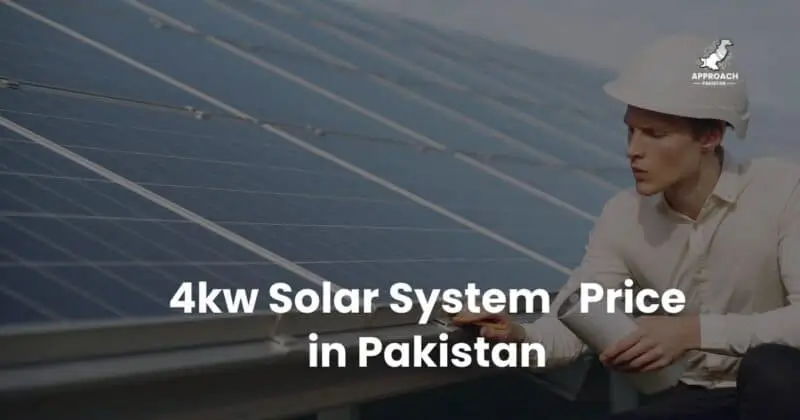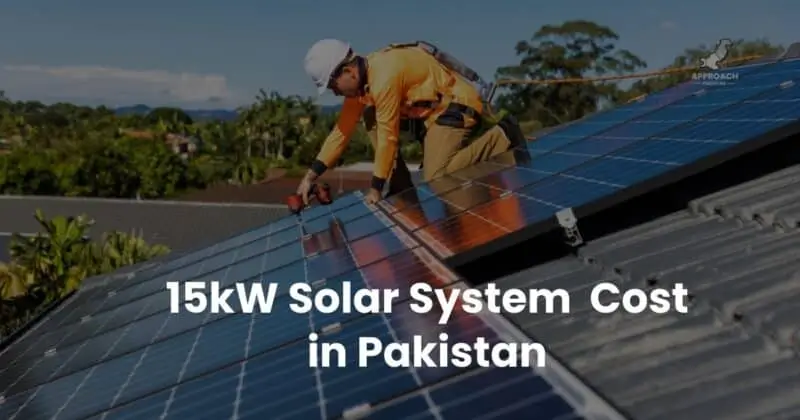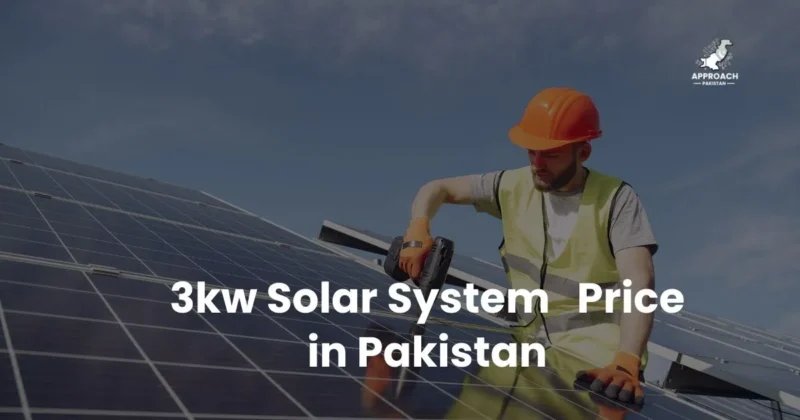On-Grid Solar Systems price in Pakistan 2025
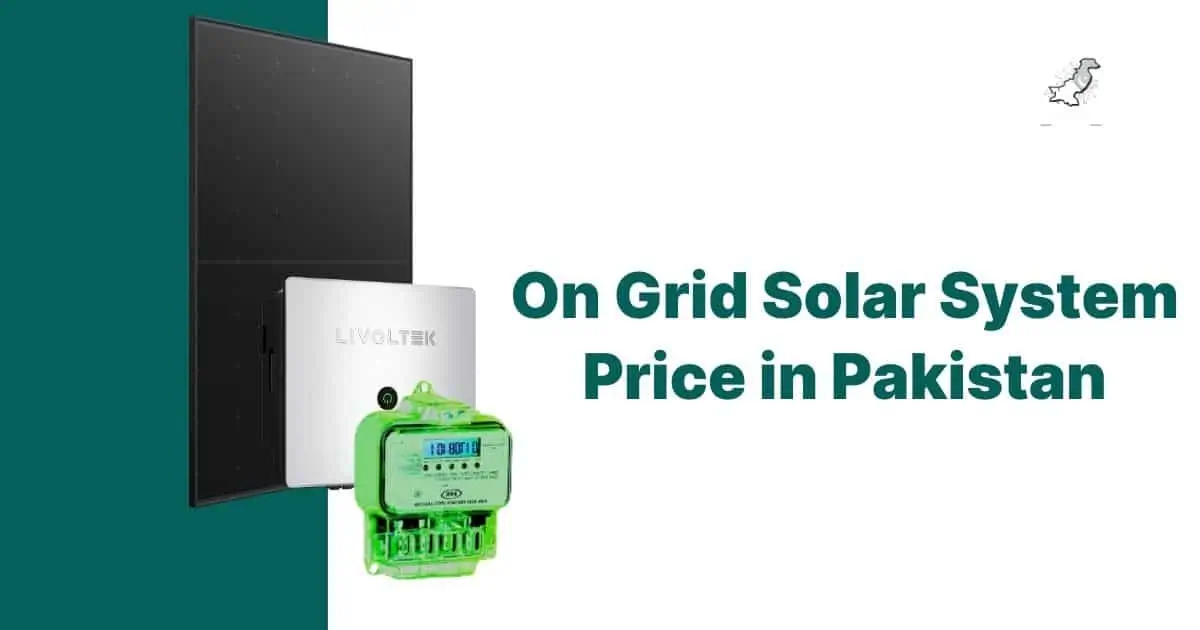
On-grid solar system prices in Pakistan range from PKR 120,000 for a 3kW system to PKR 2,800,000 for a 30kW commercial installation. These grid-tied systems connect directly to your utility supply, eliminate battery costs, and offer the fastest payback period of 2-4 years through net metering benefits. Installation costs include panels, inverters, mounting structures, and professional setup services.
Your electricity bill eating into your monthly budget? You’re not alone. Thousands of Pakistani families watch their hard-earned money disappear into sky-high utility costs every month. The constant threat of load shedding disrupts your daily routine, while confusing solar pricing leaves you wondering if you’re being overcharged.
Here’s the thing: on-grid solar systems can slash your electricity bills by 70-80% without the complexity of battery storage. But choosing the wrong system size or falling for hidden costs can turn your solar dream into a financial nightmare.
This guide cuts through the confusion. You’ll get transparent pricing, clear system comparisons, and the exact information needed to make the right choice for your home or business.
What is an On-Grid Solar System?
Understanding the Basics of On-Grid Solar Systems
An on-grid solar system connects directly to your local electricity grid. Think of it as your home becoming a mini power plant. During sunny days, your solar panels generate electricity that powers your appliances and feeds excess energy back into the grid.
The beauty lies in its simplicity. No batteries, no complex storage systems, just clean energy flowing straight from your roof to your appliances. When your panels aren’t producing enough power (like at night), you draw electricity from the grid as usual.
How On-Grid Solar Systems Work
Picture this: it’s noon and your solar panels are working overtime. Your 10kW system is generating 8kW of power, but your home only needs 5kW. Where does that extra 3kW go? Straight into the grid, spinning your net meter backwards and earning you credits.
When evening arrives and your panels stop producing, you use those credits to power your home. It’s like having an invisible battery the size of the entire national grid. Your net meter keeps track of what you give and what you take, settling the score at month’s end.
The process is seamless. One moment you’re buying electricity, the next you’re selling it back to the utility company. All automatically, without you lifting a finger.
On-Grid vs Off-Grid vs Hybrid Solar Systems
Here’s where things get interesting. On-grid systems cost 40-50% less than off-grid alternatives because they skip expensive battery storage. An off-grid system needs massive battery banks to store power for nighttime use, driving costs through the roof.
Hybrid systems try to bridge both worlds. They connect to the grid but include battery backup for power outages. Sounds perfect? The catch is price – hybrid systems cost 60-80% more than pure on-grid setups.
For most Pakistani homes, on-grid makes perfect sense. You get maximum savings with minimum investment. The grid acts as your backup power source, eliminating the need for costly batteries.
Key Components of On-Grid Solar Systems
Solar Panels (Types & Specifications)
Solar panels are your system’s workhorses. In Pakistan’s market, you’ll find three main types: monocrystalline, polycrystalline, and thin-film panels. Monocrystalline panels dominate because they offer the highest efficiency (20-22%) in our limited roof space.
A typical residential panel produces 400-550 watts. Top brands like Jinko, Canadian Solar, and JA Solar deliver 25-year warranties with guaranteed performance. Expect panels to maintain 80% efficiency after two decades of Pakistani sun and monsoon seasons.
The math is simple: higher wattage panels mean fewer panels needed. A 540W panel requires less mounting hardware and installation labor compared to multiple 400W panels for the same capacity.
Solar Inverters (String vs Micro Inverters)
Inverters transform DC power from panels into AC power your home uses. String inverters handle multiple panels in series, making them cost-effective for most installations. A quality 10kW string inverter costs PKR 150,000-200,000.
Micro inverters attach to individual panels, optimizing each panel’s performance separately. They cost 30-40% more but deliver 5-15% higher energy harvest. Perfect for roofs with shading issues or complex layouts.
Power optimizers offer a middle ground – combining string inverter economics with panel-level optimization. They’re gaining popularity in Pakistani markets for their balanced cost-performance ratio.
Mounting Structure & Installation Hardware
Your mounting system must survive Pakistan’s extreme weather. From scorching summers to monsoon winds, quality mounting hardware protects your investment. Aluminum rails and stainless steel clamps resist corrosion in our humid climate.
Ground-mounted systems need concrete foundations and robust steel structures. Roof-mounted systems require careful waterproofing and load calculations. Professional installers assess your roof’s structural capacity before recommending system size.
Ballasted systems work well for flat commercial roofs. They don’t penetrate the roof surface, making them ideal for rented properties or buildings with waterproofing concerns.
Net Metering System & Smart Meters
Net metering transforms your regular meter into a smart bidirectional meter. This device tracks electricity flowing both ways – from grid to home and from solar system to grid. NEPRA (National Electric Power Regulatory Authority) mandates specific meter types for net metering applications.
The installation process involves your utility company replacing your existing meter. Most DISCOs (Distribution Companies) complete meter installation within 2-3 weeks of application approval. The meter costs PKR 15,000-25,000, usually charged by the utility company.
Smart meters provide real-time data on your energy consumption and generation. Some models offer mobile apps for monitoring your system’s performance remotely.
Safety Components & Protection Equipment
Safety isn’t optional in solar installations. AC and DC disconnect switches allow safe system shutdown during maintenance. Circuit breakers protect against overcurrent conditions that could damage equipment or cause fires.
Surge protection devices guard against lightning strikes and grid fluctuations. In Pakistan’s unpredictable electrical environment, quality surge protectors prevent thousands of rupees in equipment damage. Ground fault circuit interrupters (GFCIs) detect dangerous current leaks.
Rapid shutdown devices comply with safety codes, automatically turning off panel output when the main disconnect is triggered. This protects firefighters and maintenance workers from energized panels.
Monitoring Systems
Monitoring systems are your window into solar performance. Basic monitoring tracks daily, monthly, and yearly energy production. Advanced systems identify underperforming panels, inverter faults, and maintenance needs.
Most modern inverters include built-in monitoring accessible via smartphone apps. Cloud-based platforms store years of performance data, helping optimize your system’s output. Some installers offer monitoring services as part of their maintenance packages.
Performance alerts notify you immediately when production drops below expected levels. Early detection prevents minor issues from becoming major problems.
On-Grid Solar System Sizes & Packages in Pakistan
Residential Solar Systems
5kW On-Grid Solar System Package
System Components & Specifications
A 5kW system typically includes 10-12 solar panels (450-500W each), one 5kW string inverter, aluminum mounting rails, and safety equipment. This setup requires roughly 350-400 square feet of unshaded roof space.
Quality components include Tier-1 solar panels with 25-year warranties, IP65-rated inverters for weather protection, and hot-dip galvanized mounting structures. Professional installation ensures optimal panel orientation and secure mounting.
The system generates approximately 650-750 units monthly, depending on location and weather conditions. Lahore and Karachi typically see higher production than northern cities due to better solar irradiance.
Price Range & Installation Cost
5kW on-grid solar system prices range from PKR 550,000 to PKR 750,000 including installation. Premium components push costs toward the higher end, while entry-level systems start around PKR 550,000. Installation labor adds PKR 50,000-80,000 depending on roof complexity.
Financing options reduce upfront costs significantly. Many banks offer solar loans at 12-15% markup rates with 3-5 year terms. Leasing programs require zero down payment but typically cost 20-30% more over system lifetime.
Government incentives may reduce net costs. Some provinces offer rebates or tax exemptions on solar equipment imports.
Suitable Appliances & Load Coverage
A 5kW system comfortably powers essential household appliances during daylight hours. This includes LED lighting, ceiling fans, refrigerator, washing machine, and small air conditioning units. Average Pakistani homes consume 3-4kW during peak daytime hours.
The system handles sudden load spikes like microwave or iron usage without grid dependency. However, running multiple high-power appliances simultaneously may require grid support. Smart usage patterns maximize solar utilization.
Energy-efficient appliances stretch your solar capacity further. Inverter ACs, LED lighting, and energy-star rated appliances reduce overall consumption, leaving more solar energy for net metering credits.
Monthly Electricity Generation
Expect 650-750 units monthly from a properly installed 5kW system. Karachi averages 720 units monthly, while Lahore produces around 680 units. Northern cities like Islamabad generate 580-620 units due to lower solar irradiance.
Summer months (April-September) see peak production of 800-900 units monthly. Winter production drops to 400-500 units but remains substantial. Annual generation totals 7,500-8,500 units for most Pakistani locations.
Dust accumulation reduces output by 15-25% without regular cleaning. Monthly panel cleaning maintains optimal performance throughout the year.
10kW On-Grid Solar System Package
System Components & Specifications
A 10kW system doubles the 5kW setup with 20-24 panels, a 10kW string inverter, and expanded mounting infrastructure. Roof space requirements increase to 700-800 square feet for optimal panel placement.
Higher capacity systems often use multiple MPPT (Maximum Power Point Tracking) channels in the inverter. This optimizes performance when panels face different directions or experience varying shading conditions.
Commercial-grade mounting systems handle larger installations with enhanced wind and seismic load ratings. Professional structural assessment ensures roof capacity matches system weight and wind loads.
Price Range & Installation Cost
10kW on-grid solar system prices range from PKR 1,100,000 to PKR 1,450,000 fully installed. Economies of scale reduce per-watt costs compared to smaller systems. Installation complexity increases with system size, adding PKR 100,000-150,000 in labor costs.
Bulk purchasing agreements with installers can reduce component costs by 10-15%. Commercial financing terms often beat residential loan rates for larger systems. Some businesses qualify for accelerated depreciation benefits.
Net metering applications for 10kW+ systems may require additional technical documentation and utility approvals.
Suitable Appliances & Load Coverage
A 10kW system powers medium to large homes with central air conditioning, multiple appliances, and commercial equipment. Small offices, clinics, and retail shops find 10kW systems ideal for their energy needs.
The system handles 8-10kW of simultaneous load during peak generation hours. This covers home offices, workshop equipment, and multiple air conditioning units running concurrently. Grid connection provides backup for higher loads.
Commercial applications include small manufacturing, food processing, and retail operations. The system reduces commercial electricity costs by 60-80% during business hours.
Monthly Electricity Generation
A 10kW system generates 1,300-1,500 units monthly across Pakistan. Karachi installations produce up to 1,440 units monthly, while Lahore averages 1,360 units. Cooler northern regions generate 1,160-1,240 units monthly.
Annual production reaches 15,000-18,000 units for most locations. Summer peak months can generate 1,800+ units, while winter production stabilizes around 800-1,000 units monthly.
Performance monitoring becomes crucial at this scale. Production variations indicate maintenance needs or equipment issues requiring professional attention.
15kW On-Grid Solar System Package
System Components & Specifications
A 15kW system represents the upper limit for most residential applications. The setup includes 30-36 panels, either a single 15kW inverter or multiple smaller inverters for redundancy. Roof space requirements reach 1,000-1,200 square feet.
Three-phase electrical connection becomes standard at this capacity. Most Pakistani homes have single-phase connections, requiring electrical upgrades for 15kW systems. Commercial properties typically have three-phase infrastructure ready.
Advanced monitoring systems track performance across multiple inverter strings. This granular data helps optimize maintenance schedules and identify underperforming sections quickly.
Price Range & Installation Cost
15kW on-grid solar system prices range from PKR 1,650,000 to PKR 2,200,000 including professional installation. Larger systems achieve better per-watt pricing through bulk component purchases and installation efficiencies.
Three-phase electrical upgrades add PKR 75,000-125,000 to total project costs. Ground-mounted options may be necessary for homes with insufficient roof space, adding foundation and mounting costs.
Commercial financing becomes attractive at this scale. Equipment financing, power purchase agreements, and solar leasing provide alternatives to upfront cash payments.
Suitable Appliances & Load Coverage
A 15kW system powers large homes, small businesses, or light industrial applications. The capacity handles multiple central AC units, commercial kitchens, workshop equipment, and office infrastructure simultaneously.
Peak daytime load coverage reaches 12-14kW without grid dependency. This supports energy-intensive operations like welding, large motors, and commercial food preparation equipment.
Hotels, restaurants, small factories, and medical facilities benefit from 15kW installations. The system size matches typical daytime energy consumption for these commercial applications.
Monthly Electricity Generation
Expect 1,950-2,250 units monthly from a 15kW system. Karachi leads with 2,160 units monthly average, followed by Lahore at 2,040 units. Northern cities produce 1,740-1,860 units monthly.
Annual generation totals 22,500-27,000 units across Pakistani locations. Peak summer months can produce 2,700+ units, while winter months maintain 1,200-1,500 units monthly production.
Commercial applications benefit from consistent daytime generation matching business hours. Weekend production feeds entirely into the grid, maximizing net metering credits.
Commercial Solar Systems
20kW On-Grid Solar System Package
Complete System Details & Components
Commercial 20kW systems require robust three-phase inverters, commercial-grade panels, and engineered mounting structures. The installation includes 40-48 panels arranged across 1,400-1,600 square feet of roof or ground space.
Multiple inverter configurations provide redundancy and optimization. Two 10kW inverters offer backup capability if one unit fails. Single 20kW inverters provide cost savings but create single points of failure.
Commercial installations require detailed engineering drawings, structural assessments, and utility interconnection studies. Professional project management ensures compliance with commercial building codes and safety standards.
Price Analysis
20kW commercial on-grid systems cost PKR 2,200,000 to PKR 2,800,000 installed. Commercial pricing benefits from bulk purchasing, streamlined permitting, and efficient installation practices.
Equipment costs represent 60-70% of total project budget. Installation, permitting, and commissioning add the remaining 30-40%. Commercial sites often require specialized equipment like cranes or lift equipment for roof access.
Cash purchases provide best pricing, but commercial financing offers tax advantages. Equipment financing, solar loans, and power purchase agreements spread costs over 5-10 year terms.
Commercial Applications
Manufacturing facilities, warehouses, retail centers, and office buildings represent typical 20kW applications. The system size matches energy consumption for small to medium commercial operations.
Daytime load matching optimizes solar utilization. Businesses operating primarily during daylight hours achieve 80-90% solar utilization rates. Evening operations rely more heavily on net metering credits.
Cold storage facilities, textile mills, and food processing operations benefit from consistent daytime energy generation. The system reduces commercial electricity costs by 70-85% during peak production hours.
ROI & Payback Period
Commercial 20kW systems achieve 2.5-3.5 year payback periods through high electricity rates and optimal utilization. Commercial electricity rates (PKR 20-30 per unit) exceed residential rates, improving project economics.
Annual savings reach PKR 750,000-1,200,000 for typical commercial applications. Net metering credits provide additional revenue during low-consumption periods. Tax benefits and depreciation improve overall returns.
System lifetime spans 25+ years with proper maintenance. Total lifetime savings range from PKR 15-25 million, providing excellent return on investment for commercial operations.
25kW On-Grid Solar System Package
System Components & Specifications
A 25kW commercial system represents serious solar capacity requiring professional project management. The installation includes 50-60 panels, commercial three-phase inverters, and engineered mounting systems designed for 25+ year operation.
Ground-mounted systems become common at this scale due to roof space limitations. Concrete foundations, steel mounting structures, and professional site preparation ensure system stability in Pakistan’s climate conditions.
Electrical infrastructure upgrades often accompany large installations. Three-phase panel upgrades, transformer sizing, and utility interconnection studies ensure safe grid connection.
Price Range & Installation Cost
25kW commercial systems range from PKR 2,750,000 to PKR 3,500,000 fully commissioned. Commercial pricing achieves economy of scale benefits while requiring specialized installation expertise.
Site preparation, electrical upgrades, and commissioning add significant costs beyond basic equipment. Ground-mounted systems require surveying, excavation, and concrete work increasing total project investment.
Commercial financing options include equipment loans, solar leasing, and power purchase agreements. These financing structures preserve cash flow while providing immediate electricity savings.
Industrial Applications
Medium manufacturing, textile operations, food processing, and large retail facilities utilize 25kW systems effectively. The capacity matches energy consumption for operations employing 50-100 people during daylight hours.
Agricultural applications include cold storage, dairy operations, and grain processing facilities. Consistent daytime generation aligns with agricultural processing schedules and irrigation requirements.
Educational institutions, hospitals, and government buildings represent ideal 25kW applications. These facilities operate primarily during daylight hours with predictable energy consumption patterns.
30kW On-Grid Solar System Package
System Components & Specifications
A 30kW system approaches utility-scale installations requiring specialized expertise and equipment. The system includes 60-75 panels, multiple commercial inverters, and engineered mounting systems rated for extreme weather conditions.
Electrical design becomes complex with load distribution, transformer sizing, and utility interconnection requirements. Professional electrical engineers design systems meeting commercial building codes and utility standards.
Monitoring and maintenance systems become essential at this scale. Remote monitoring, automated alerts, and preventive maintenance schedules protect the substantial investment while maximizing energy production.
Price Range & Installation Cost
30kW commercial installations cost PKR 3,300,000 to PKR 4,200,000 complete. Large system pricing achieves maximum economy of scale while requiring specialized installation and commissioning services.
Engineering, permitting, and commissioning represent larger portions of total costs. Complex installations require structural engineers, electrical consultants, and specialized construction equipment.
Financing becomes sophisticated with multiple options including equipment financing, tax-based financing, and power purchase agreements structured for commercial operations.
Large Commercial Applications
Large manufacturing, industrial operations, shopping centers, and institutional facilities require 30kW capacity. The system size matches energy consumption for facilities with 100+ employees or substantial equipment loads.
Industrial applications include textile mills, steel fabrication, chemical processing, and large cold storage facilities. Consistent daytime generation matches industrial operating schedules and energy-intensive processes.
Multi-tenant commercial buildings, hotels, hospitals, and universities represent institutional applications. These facilities benefit from predictable daytime energy consumption and professional facility management.
On-Grid Solar System Prices in Pakistan 2025
Factors Affecting Solar System Prices
Solar component prices fluctuate based on global manufacturing, shipping costs, and currency exchange rates. Pakistani rupee depreciation against the dollar directly impacts equipment costs since most components are imported.
Installation complexity significantly affects total project costs. Simple roof installations cost less than complex layouts requiring specialized mounting or electrical upgrades. Ground-mounted systems require foundation work and site preparation.
Quality levels create substantial price variations. Tier-1 panels with 25-year warranties cost 30-40% more than basic panels but provide superior performance and longevity. Professional installation ensures optimal performance and warranty compliance.
Price Comparison by System Size
System size economics favor larger installations through bulk purchasing and installation efficiencies. Per-watt costs decrease significantly from small residential to large commercial systems.
3kW systems: PKR 140-160 per watt 5kW systems: PKR 110-140 per watt 10kW systems: PKR 100-125 per watt 15kW+ systems: PKR 90-115 per watt
Commercial installations achieve better pricing through simplified permitting, bulk purchasing, and streamlined installation processes. Residential installations require more customization and individual attention.
Cost Per Watt Analysis
Pakistani solar costs compare favorably with regional markets. India averages PKR 85-100 per watt, while Bangladesh costs reach PKR 120-140 per watt. Local assembly and reduced shipping costs benefit Pakistani consumers.
Premium system components increase per-watt costs but deliver superior performance and warranties. Tier-1 panels, string inverters with optimizers, and aluminum mounting systems justify higher costs through improved reliability.
Budget systems start around PKR 80-90 per watt but may compromise on component quality or installation standards. Evaluate total cost of ownership including maintenance, repairs, and replacement costs over 25 years.
Installation & Labor Costs
Professional installation adds PKR 15-25 per watt to total system costs. Certified installers provide proper mounting, electrical connections, and commissioning ensuring optimal performance and safety compliance.
DIY installation isn’t recommended for grid-tied systems due to electrical complexity and safety requirements. Improper installation voids equipment warranties and creates safety hazards. Professional installation includes permits, inspections, and utility interconnection.
Regional cost variations reflect local labor markets and competition levels. Major cities offer competitive pricing through installer competition, while rural areas may see 10-20% higher installation costs.
Government Incentives & Subsidies
Current government policies exempt solar equipment from import duties and sales taxes. These exemptions reduce system costs by 15-20% compared to full taxation scenarios.
Provincial governments offer various incentive programs. Punjab’s solar financing program provides subsidized loans, while Sindh offers net metering fast-track approvals. KPK and Balochistan have launched solar promotion initiatives.
Net metering itself represents a significant incentive by allowing grid sales of surplus energy. This virtual storage eliminates battery costs while providing revenue from excess generation.
Net Metering in Pakistan
What is Net Metering?
Net metering allows solar system owners to sell excess electricity back to the grid at retail rates. Your bidirectional meter tracks energy flowing both directions, crediting your account for surplus generation.
Think of the grid as a massive battery. During sunny periods, you deposit excess energy. At night or cloudy days, you withdraw stored credits. Monthly bills reflect the net difference between consumption and generation.
NEPRA regulations require utilities to offer net metering for systems up to 1MW capacity. All major DISCOs (K-Electric, LESCO, FESCO, etc.) provide net metering services with standardized application processes.
Net Metering Application Process
The application process starts with submitting technical documents to your local DISCO. Required documents include system design, equipment specifications, electrical diagrams, and structural assessments for larger systems.
DISCO technical teams review applications within 15-30 days. Site inspections verify installation quality and safety compliance. Approved systems receive new bidirectional meters and grid interconnection permissions.
Application fees range from PKR 5,000-15,000 depending on system size and DISCO policies. Meter replacement costs PKR 15,000-25,000, usually billed separately by the utility company.
Net Metering Benefits & Requirements
Net metering eliminates the need for expensive battery storage while providing grid backup during equipment maintenance. Your system continues generating revenue even when appliances aren’t consuming power.
Grid connection provides unlimited backup capacity for high-load appliances or cloudy weather periods. This flexibility allows optimal appliance usage without worrying about solar generation timing.
Requirements include approved equipment lists, certified installer, proper electrical protection, and utility-approved meter installation. Systems must meet NEPRA technical standards and local building codes.
Net Metering Policy Updates 2025
Recent policy updates streamline application processes and reduce approval timeframes. NEPRA has standardized net metering procedures across all DISCOs, eliminating regional variations and delays.
New regulations allow virtual net metering for apartment buildings and shared facilities. This enables solar adoption in multi-tenant buildings where individual metering was previously impossible.
Simplified procedures for systems under 10kW reduce paperwork and approval times. Larger systems still require detailed technical reviews but benefit from standardized processes.
Earning from Surplus Energy Production
Surplus energy earns credits at current electricity rates. These credits offset future consumption at the same rate, providing full retail value for your solar generation.
Annual true-up settlements reconcile yearly production and consumption. Excess credits may carry forward to the following year, though policies vary by DISCO. Some utilities provide cash payments for annual surplus.
Strategic energy management maximizes net metering benefits. Running high-consumption appliances during peak solar hours minimizes grid purchases while maximizing credit accumulation.res bidirectional meter installation. Your utility company handles this process after system approval.le.
On Grid Solar Installation Requirements & Considerations
Area Required for Different System Sizes
Solar panel installations require unshaded roof space with proper orientation. A typical 400W panel measures 6.5 x 3.5 feet, requiring approximately 23 square feet including spacing for maintenance access.
3kW system: 250-300 square feet 5kW system: 350-400 square feet 10kW system: 700-800 square feet 15kW system: 1,000-1,200 square feet
Ground-mounted systems require additional space for access roads, maintenance areas, and setbacks from property boundaries. Commercial installations often use ground mounting for easier maintenance and optimal panel orientation.
Roof Suitability Assessment
Professional roof assessments evaluate structural capacity, age, condition, and orientation. Roofs older than 10 years may require reinforcement or repair before solar installation to ensure 25-year system life.
Ideal roof orientation faces south with 30-degree tilt angles. East-west orientations work acceptably with slight production reductions. North-facing roofs aren’t suitable for solar installations in Pakistan’s geographic location.
Shading analysis identifies trees, buildings, or structures affecting panel performance. Even partial shading can significantly reduce system output, requiring panel layout optimization or shading mitigation strategies.
Structural Requirements
Roof loading calculations ensure structural capacity for panel weight, mounting hardware, and wind loads. Typical installations add 25-35 kg per square meter including panels, mounting rails, and hardware.
Waterproofing considerations prevent roof leaks around mounting penetrations. Quality installers use proper flashing, sealants, and mounting techniques to maintain roof integrity throughout system lifetime.
Building codes require proper electrical grounding, disconnect switches, and safety labeling. Professional installers ensure compliance with local electrical codes and safety standards.
Electrical Infrastructure Assessment
Electrical panel capacity and condition determine system size limitations. Older panels may require upgrades to handle solar system interconnection safely. Three-phase systems need balanced loading across all phases.
Grid connection points require utility coordination and approval. Service panel modifications, disconnect switch installation, and meter replacement require professional electrical work.
Electrical code compliance includes proper grounding, GFCI protection, rapid shutdown devices, and safety labeling. These safety systems protect property and personnel during normal operation and emergency situations.
Permits & Approvals Required
Building permits ensure compliance with local construction and electrical codes. Most municipalities require permit applications, plan reviews, and inspection approvals before system commissioning.
Utility interconnection agreements formalize grid connection terms and net metering arrangements. These agreements specify technical requirements, safety procedures, and operational guidelines.
NEPRA approvals apply to larger commercial systems requiring detailed technical reviews. Residential systems under 10kW benefit from simplified approval processes reducing paperwork and approval times.
Financial Analysis & Savings
Monthly Electricity Bill Reduction
On-grid solar systems typically reduce electricity bills by 70-80% through direct consumption and net metering credits. A properly sized system can eliminate fixed charges while maintaining grid connection for backup power.
Monthly savings depend on system size, consumption patterns, and local electricity rates. A 5kW system saves PKR 8,000-12,000 monthly, while 10kW systems save PKR 16,000-24,000 monthly for typical residential users.
Commercial installations achieve higher savings due to elevated commercial electricity rates. Businesses often see monthly savings of PKR 30,000-80,000 from properly sized commercial solar installations.
Payback Period Calculation
Payback periods for on-grid systems range from 2-4 years depending on system size, electricity consumption, and local rates. Higher electricity rates and optimal system sizing reduce payback periods significantly.
Residential systems (5-10kW): 3-4 years Commercial systems (15-30kW): 2.5-3.5 years Industrial systems (50kW+): 2-3 years
Net metering accelerates payback by providing full retail credit for surplus generation. Without net metering, payback periods would extend to 5-7 years due to reduced system utilization.
Return on Investment (ROI)
Solar investments typically provide 25-35% annual returns through electricity savings and net metering credits. These returns exceed most traditional investment options while providing energy independence.
System lifetime spans 25+ years with minimal maintenance requirements. Total lifetime returns often exceed 800-1200% of initial investment through accumulated electricity savings.
Commercial installations provide additional benefits through tax depreciation, business expense deductions, and improved property valuations. These factors enhance overall investment returns beyond direct electricity savings.
Long-term Savings Analysis
25-year savings projections account for electricity rate inflation, system performance degradation, and maintenance costs. Conservative projections assume 3-5% annual electricity rate increases and 0.5% annual performance degradation.
5kW system lifetime savings: PKR 2.5-3.5 million 10kW system lifetime savings: PKR 5-7 million 15kW system lifetime savings: PKR 7.5-10.5 million
Performance warranties guarantee 80% output after 25 years, ensuring long-term savings realization. Quality installations with proper maintenance often exceed warranty performance levels.
Financing Options Available
Solar financing makes installations accessible without large upfront investments. Banks, NBFCs, and specialized solar financiers offer various loan products with competitive terms.
Bank loans: 12-18% markup, 3-7 year terms NBFCs: 15-20% markup, 2-5 year terms Equipment financing: 10-15% markup, 5-8 year terms
Leasing programs require zero down payment but cost 20-30% more over system lifetime. Power purchase agreements (PPAs) provide electricity at fixed rates without equipment ownership.
Advantages of On-Grid Solar Systems
Lower Electricity Bills & Costs
On-grid systems provide immediate electricity bill reductions from day one of operation. Unlike off-grid systems requiring expensive battery storage, grid-tied systems achieve maximum cost efficiency through net metering.
Daytime solar generation directly powers appliances at zero marginal cost. Excess generation earns full retail credits through net metering, maximizing system value without battery investment.
Grid connection eliminates generator costs, fuel expenses, and battery replacement cycles. Your total energy costs drop dramatically while maintaining full electrical capacity and reliability.
No Battery Requirements
Eliminating batteries reduces system costs by 40-60% compared to off-grid alternatives. Batteries require replacement every 5-10 years, adding ongoing costs and maintenance requirements throughout system lifetime.
Grid connection provides unlimited backup capacity for high-power appliances and extended cloudy periods. This virtual storage capacity exceeds any practical battery installation while requiring zero maintenance.
Battery-free operation simplifies system design, reduces maintenance requirements, and eliminates safety concerns associated with large battery banks. Your system operates reliably without complex energy management systems.
Grid Stability & Energy Security
Grid connection provides stable voltage and frequency regulation impossible with standalone systems. Utility infrastructure handles load balancing, frequency control, and voltage regulation automatically.
Power quality remains consistent regardless of solar generation variations. Cloud cover, seasonal changes, and equipment maintenance don’t affect your electrical supply quality or reliability.
Energy security improves through diversified supply sources. Solar generation during the day, grid backup at night, and net metering credits provide multiple layers of energy security.
Environmental Benefits
Solar systems eliminate carbon emissions from grid electricity consumption. A typical 10kW system prevents 12-15 tons of CO2 emissions annually, equivalent to planting 150-200 trees yearly.
Reduced grid demand decreases strain on Pakistan’s fossil fuel power plants. Widespread solar adoption reduces national fuel imports and improves energy independence.
Net metering enables distributed generation, reducing transmission losses and improving grid efficiency. Local generation reduces infrastructure strain while providing environmental benefits.
Low Maintenance & High Durability
Solar panels require minimal maintenance beyond periodic cleaning and visual inspections. No moving parts, fuel requirements, or complex maintenance schedules reduce ongoing operational costs.
25-year panel warranties and 5-10 year inverter warranties provide long-term reliability assurance. Quality installations operate reliably with minimal intervention throughout their lifetime.
Cleaning panels monthly maintains optimal performance. Basic maintenance includes checking connections, monitoring performance, and keeping panels free from dust and debris.
Quick Return on Investment
On-grid systems provide fastest payback periods among renewable energy options. Immediate electricity savings begin from day one, with full cost recovery typically within 2-4 years.
High electricity rates in Pakistan accelerate investment returns. Commercial rates exceeding PKR 25-30 per unit provide substantial savings opportunities that quickly offset system costs.
Net metering maximizes investment returns by crediting surplus generation at full retail rates. This eliminates the need for expensive battery storage while providing revenue from excess production.
Choosing the Right Solar System Provider
Key Factors to Consider
Installation quality directly impacts system performance and longevity. Research installer experience, certifications, and local project portfolios before making decisions. Poor installation can reduce performance by 15-25% permanently.
Financial stability of your installer affects warranty support and long-term service availability. Choose established companies with proven track records and local presence for ongoing support.
Component quality varies dramatically across price ranges. Tier-1 panels, quality inverters, and proper mounting hardware justify higher costs through improved performance and reliability.
Quality Certifications & Standards
Look for installers certified by equipment manufacturers and industry organizations. NABCEP (North American Board of Certified Energy Practitioners) certification, though not local, indicates professional training and competence.
Equipment certifications include IEC standards for panels, UL listings for inverters, and quality management certifications for manufacturers. These standards ensure equipment meets international safety and performance requirements.
Installation standards include proper electrical work, structural mounting, and safety compliance. Professional installers follow manufacturer guidelines and local electrical codes for optimal performance and safety.
Warranty & After-Sales Service
Panel warranties typically include 25-year performance guarantees and 10-15 year product warranties. Inverter warranties range from 5-12 years depending on quality level and manufacturer.
Installation warranties should cover workmanship for minimum 5-10 years. This protects against mounting failures, electrical issues, and weather-related problems caused by improper installation.
Local service availability becomes crucial for maintenance and warranty claims. Choose installers with local service teams and parts inventory for quick issue resolution.
Installation Experience & Portfolio
Review installer portfolios focusing on similar-sized projects in your area. Residential installers may lack commercial experience, while commercial installers might not understand residential requirements.
Ask for local references and visit completed installations when possible. Satisfied customers provide honest feedback about installation quality, service levels, and long-term performance.
Experience with your local utility and permitting processes streamlines project completion. Installers familiar with local requirements avoid delays and ensure smooth interconnection processes.
Customer Reviews & Testimonials
Online reviews provide insights into customer satisfaction, service quality, and problem resolution. Look for patterns in reviews rather than focusing on individual complaints or praise.
Better Business Bureau ratings and complaint resolution records indicate professional business practices. Established companies typically have systems for handling customer concerns professionally.
Social media presence and customer engagement demonstrate company stability and customer service commitment. Active companies respond to questions and maintain professional online presence.
On Grid Solar System Performance & Monitoring
Expected Energy Generation by System Size
System performance varies by location, season, and installation quality. Karachi and southern regions achieve higher annual production than northern areas due to superior solar irradiance.
Annual Generation Expectations:
- 3kW: 3,900-4,500 units
- 5kW: 6,500-7,500 units
- 10kW: 13,000-15,000 units
- 15kW: 19,500-22,500 units
Peak summer months generate 30-40% more than winter months. Monsoon seasons temporarily reduce production but annual totals remain predictable for financial planning.
Performance Monitoring Tools
Modern inverters include built-in monitoring accessible via smartphone apps or web portals. Real-time data includes current production, daily/monthly/yearly totals, and system status alerts.
Advanced monitoring identifies underperforming panels, inverter faults, and maintenance needs. Early problem detection prevents minor issues from becoming major repairs or production losses.
Cloud-based monitoring stores historical data for trend analysis and warranty claims. Professional installers often provide monitoring services as part of maintenance packages.
Seasonal Performance Variations
Summer months (April-September) provide peak solar production with long daylight hours and minimal cloud cover. Systems typically generate 130-150% of annual average during these months.
Winter performance drops to 60-80% of annual average due to shorter days and occasional cloudy weather. However, cooler temperatures actually improve panel efficiency partially offsetting reduced sunlight.
Monsoon season impact varies by region. Coastal areas experience more significant reductions than inland areas, but annual production remains predictable for financial planning.
Maintenance Requirements
Monthly panel cleaning maintains optimal performance, especially during dusty seasons. Clean panels produce 15-25% more electricity than dusty panels in Pakistan’s climate.
Annual professional inspections identify potential issues before they affect performance. Check mounting hardware, electrical connections, and inverter operation for optimal system health.
Inverter replacement typically occurs after 10-15 years of operation. Budget PKR 100,000-200,000 for inverter replacement depending on system size and technology advances.

